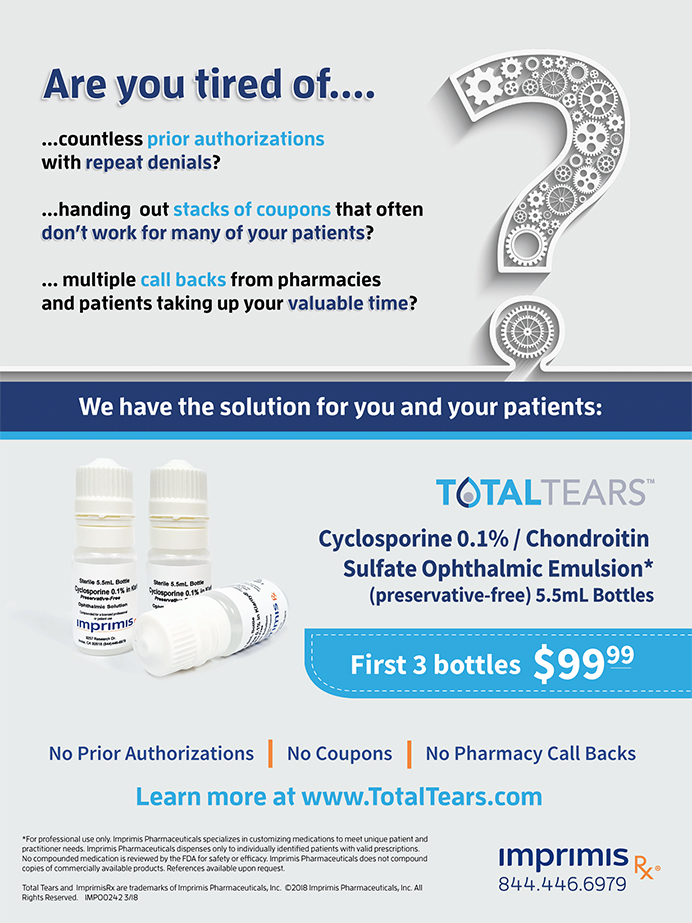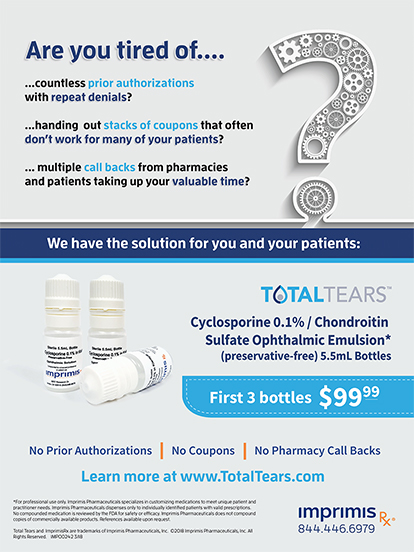As an optometrist working alongside a high-volume cataract surgeon, I am tasked with providing perioperative care and educating patients on IOL options. It is imperative that I stay up to date on IOL technology. I’ve found that the most effective way to stay educated is to take advantage of every resource available to me.
INTERNET
One of the biggest assets we all have at our fingertips is the internet. Manufacturers do a great job on their websites of outlining IOL indications and features. However, company websites are often forms of advertisement, and many are geared more toward patients than clinicians. It is important to approach websites with this in mind.
INDUSTRY PERSONNEL
Industry representatives may visit your office or host a dinner. When you have the chance to engage them, do so: it will give you the opportunity to hear about their company’s IOL technologies. You can use this time to ask them lots of questions. It is vital that you challenge reps by asking them about any flaws with their company’s IOL designs and how the company is working to fix them. Make sure to have the rep compare his or her company’s products to competitors’ products, both in strengths and weaknesses. Industry reps are usually willing to point you to doctors and practices using their products. This allows you to speak directly with these colleagues to help you form an opinion.
Medical science liaisons (MSLs) are another industry source that could help you learn more about IOLs. Optometrists may not encounter MSLs as often as their surgical counterparts do, but many MSLs are happy to meet with optometrists who express an interest in education.
CONTINUING EDUCATION COURSES
Continuing education (CE) courses, particularly those geared toward refractive and cataract surgery, are one-stop shops for education on the latest technologies in IOLs. The ASCRS Annual Meeting is a great place for such education, as is the Optometric Cornea, Cataract, and Refractive Society Education Symposium. Such meetings discuss up-and-coming technologies and give you a chance to see clinicians engage in live debates about IOLs. Many CE events also showcase refractive cataract surgery, femtosecond laser technology, and perioperative management.
SURGEONS
One of the best resources for education may seem obvious, but it is often overlooked: surgeons—especially those you work with and/or refer to. It is important to know about these and other surgeons’ thoughts on particular IOLs and their postsurgical expectations. Surgeons can help guide you in learning which category of IOL works best in a particular situation.
Ask surgeons about their preferred IOLs, the side effects they have noticed with new IOLs, and how they decide when a premium IOL recommendation is warranted. Understanding your surgeon’s mindset will help you set your patients’ expectations.
Take advantage of visiting high-volume specialty practices. A single day of shadowing could be an experience that changes your outlook on the surgical process.
LITERATURE
All of the above resources can be useful, but all come with the caveat that personal experience, industry self-promotion, and presenter partiality can skew the education you receive. The peer-reviewed literature, on the other hand, generally contains little bias: The collaborative process of publication mitigates spin or prejudice found in other forms of education.
I recommend going online and subscribing to journals that appeal to you. Reading studies between patient appointments or during downtime can be an easy way to digest literature. Some studies in peer-reviewed journals detail long-term outcomes following implantation of certain IOLs; other studies offer pearls for patient management.
Reading articles in journals can help optometrists seeking education to sort out what they have digested from other sources. Think of literature as the piece that is key to solving the puzzle.
ASK AWAY!
Don’t be afraid to ask questions or probe for answers. Reach out to presenters from the podium. Write to authors whose work has appeared in peer-reviewed journals. The more knowledge you have, the more prepared you will be to comanage new refractive cataract surgery cases.






